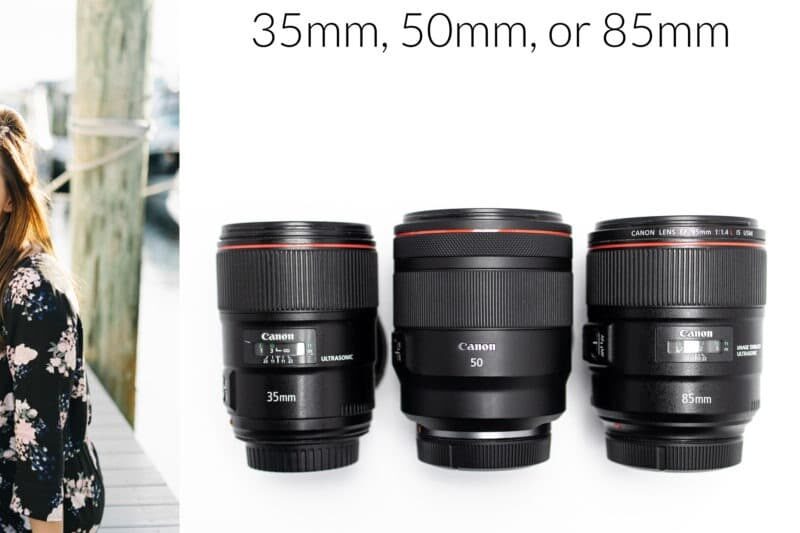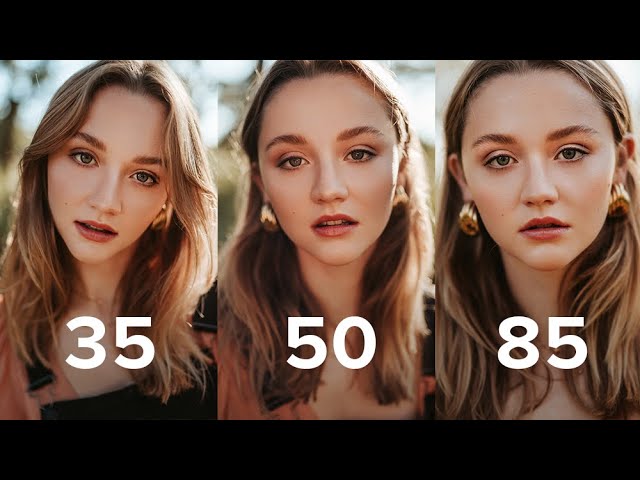Choosing the right lens for portraits can be tricky. The 35mm, 50mm, and 85mm lenses each offer unique benefits.
Portrait photography requires careful consideration of lens choice. The focal length of a lens affects the look and feel of your photos. A 35mm lens offers a wider view, making it great for environmental portraits. The 50mm lens is versatile, often called the “nifty fifty,” and provides a natural perspective.
The 85mm lens, known for its flattering compression, is ideal for close-up portraits. Understanding these differences helps you select the best lens for your needs. This guide will explore the features and uses of each lens, helping you make an informed decision for your portrait photography.

Understanding Focal Lengths
Understanding focal lengths is key to choosing the right lens for portraits. Different lenses create unique effects and impact how subjects appear. Let’s dive into what focal length means and how it affects portraits.
What Is Focal Length?
Focal length measures the distance from the lens to the image sensor. It is usually noted in millimeters (mm). This distance affects how much of the scene the lens captures. A smaller number, like 35mm, captures more of the scene. A larger number, like 85mm, captures less but magnifies the subject.
Impact On Portraits
Focal length changes the look of portraits in several ways. A 35mm lens gives a wider view and includes more background. This can make portraits feel more natural and connected to their environment. A 50mm lens offers a balanced perspective. It is often called the “nifty fifty” for its versatility. It provides a natural look without much distortion.
An 85mm lens creates a tighter shot. It focuses more on the subject and blurs the background more. This effect isolates the subject and makes them stand out. Each lens has its strengths, depending on the desired effect in the portrait.
35mm Lens For Portraits
The 35mm lens is a popular choice for portrait photography. It offers a unique perspective and can capture more of the background. This lens is versatile and can be used in various settings. Let’s explore the characteristics, best use cases, and pros and cons of the 35mm lens for portraits.
Characteristics Of 35mm
A 35mm lens has a wider field of view compared to longer focal lengths. This lens can include more context in your portraits. It provides a natural perspective similar to the human eye. The 35mm lens is lightweight and easy to carry. It typically has a fast aperture, allowing for good low-light performance.
Best Use Cases
The 35mm lens is great for environmental portraits. It captures both the subject and their surroundings. This lens is ideal for street photography. It allows you to get close to your subject without being intrusive. The 35mm lens is also suitable for group portraits. It includes everyone in the frame without distortion.
Pros And Cons
| Pros | Cons |
|---|---|
|
|
50mm Lens For Portraits
The 50mm lens is a favorite among portrait photographers. It is often called the “nifty fifty.” This lens offers a natural perspective, making it ideal for capturing lifelike portraits.
Characteristics Of 50mm
The 50mm lens has unique features that make it stand out:
- Fixed focal length
- Wide aperture, usually around f/1.8
- Lightweight and compact
- Good in low light conditions
Best Use Cases
The 50mm lens is versatile and suits many portrait scenarios:
- Indoor portraits
- Outdoor portraits
- Event photography
- Travel portraits
Pros And Cons
| Pros | Cons |
|---|---|
|
|

85mm Lens For Portraits
When choosing a lens for portrait photography, the 85mm lens is a popular choice among professionals. It offers a perfect balance between subject isolation and background compression. This lens is known for creating stunning, sharp images with beautiful background blur.
Characteristics Of 85mm
The 85mm lens has several notable characteristics that make it ideal for portraits:
- Focal Length: The 85mm focal length helps in capturing flattering portraits without distortion.
- Background Compression: It compresses the background, making it appear closer and more blurred.
- Aperture: Most 85mm lenses have a wide aperture (like f/1.8 or f/1.4), allowing for great low-light performance and shallow depth of field.
- Image Quality: These lenses are known for their sharpness and color accuracy.
Best Use Cases
The 85mm lens excels in various portrait scenarios:
- Headshots: Perfect for close-up shots, capturing facial details beautifully.
- Full-Body Portraits: Ideal for full-body shots, providing a good balance between subject and background.
- Outdoor Portraits: Great for outdoor shoots, offering excellent background blur and subject isolation.
- Studio Photography: Excellent in controlled lighting environments, capturing every detail with precision.
Pros And Cons
| Pros | Cons |
|---|---|
|
|
Comparing 35mm, 50mm, And 85mm
Choosing the right lens for portraits can be challenging. 35mm, 50mm, and 85mm lenses are popular choices. Each lens offers unique benefits and drawbacks. Understanding these differences helps in making an informed decision.
Field Of View
The field of view is crucial in portrait photography. The 35mm lens captures a wider scene. It includes more of the background. This can be useful for environmental portraits. The 50mm lens, often called the “nifty fifty,” provides a more natural perspective. It resembles what the human eye sees. The 85mm lens, on the other hand, offers a narrower view. This lens is excellent for close-up portraits. It focuses more on the subject and less on the background.
Depth Of Field
Depth of field affects how much of the photo is in focus. The 35mm lens has a deeper depth of field. More of the scene remains sharp. The 50mm lens has a medium depth of field. It offers a balance between sharpness and background blur. The 85mm lens excels in creating a shallow depth of field. It produces a beautiful bokeh effect. This makes the subject stand out against a blurry background.
Image Distortion
Image distortion can affect the appearance of portraits. The 35mm lens can cause noticeable distortion. Subjects may look stretched, especially at the edges. The 50mm lens has minimal distortion. It captures subjects accurately. The 85mm lens has the least distortion. It keeps facial features true to life. This makes it ideal for flattering portraits.

Choosing The Right Lens
Choosing the right lens for portrait photography can be challenging. Each lens has its strengths and weaknesses. The 35mm, 50mm, and 85mm lenses all offer unique perspectives. Understanding your style, shooting environment, and budget will help you make the best choice.
Consider Your Style
Your photography style plays a key role in lens choice. A 35mm lens is great for environmental portraits. It captures more background and context. This lens is ideal for storytelling.
A 50mm lens offers a natural perspective. It’s versatile and can be used in many settings. This lens is good for both close-ups and full-body shots.
The 85mm lens is perfect for classic portraits. It creates beautiful background blur. This lens isolates the subject, making them stand out.
Shooting Environment
Your shooting environment also influences lens selection. In a small studio, the 35mm lens might be more suitable. It allows you to capture more of the setting.
For outdoor shoots, the 50mm lens offers flexibility. It works well in different lighting conditions and locations.
If you prefer shooting in large spaces, the 85mm lens can be ideal. It provides a tight frame on the subject, reducing distractions.
Budget Considerations
Budget is another important factor. The 35mm lens is often more affordable. It is a good starting point for new photographers.
The 50mm lens is moderately priced. It offers great value for its versatility and quality.
The 85mm lens tends to be more expensive. It is an investment for those serious about portrait photography.
| Lens | Best For | Price Range |
|---|---|---|
| 35mm | Environmental portraits, storytelling | Low to mid-range |
| 50mm | Versatile, natural perspective | Mid-range |
| 85mm | Classic portraits, background blur | High-range |
Frequently Asked Questions
Which Lens Is Better For Portraits?
The 85mm lens is often preferred for portraits. It provides flattering compression and a natural look. However, the 50mm and 35mm lenses are versatile and can be used creatively.
What Is The Difference Between 35mm, 50mm, And 85mm Lenses?
The main difference is focal length. The 35mm is wide, the 50mm is standard, and the 85mm is telephoto. Each offers unique perspectives.
Can I Use A 35mm Lens For Portraits?
Yes, you can use a 35mm lens for portraits. It offers a wider field of view, making it great for environmental portraits.
Why Choose A 50mm Lens For Portraits?
A 50mm lens is versatile and offers a natural perspective. It’s great for both full-body and close-up portraits.
Conclusion
Choosing the best lens for portraits depends on your needs. The 35mm lens offers a wider view, great for environmental portraits. The 50mm lens is versatile and gives natural-looking results. The 85mm lens excels in creating beautiful background blur, perfect for close-ups.
Each lens has its strengths. Your choice should match your style and subject. Experiment with different lenses to find your favorite. Happy shooting!



